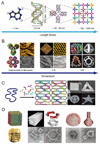Spatially-interactive biomolecular networks organized by nucleic acid nanostructures
- PMID: 22642503
- PMCID: PMC3654852
- DOI: 10.1021/ar200295q
Spatially-interactive biomolecular networks organized by nucleic acid nanostructures
Abstract
Living systems have evolved a variety of nanostructures to control the molecular interactions that mediate many functions including the recognition of targets by receptors, the binding of enzymes to substrates, and the regulation of enzymatic activity. Mimicking these structures outside of the cell requires methods that offer nanoscale control over the organization of individual network components. Advances in DNA nanotechnology have enabled the design and fabrication of sophisticated one-, two- and three-dimensional (1D, 2D, and 3D) nanostructures that utilize spontaneous and sequence-specific DNA hybridization. Compared with other self-assembling biopolymers, DNA nanostructures offer predictable and programmable interactions and surface features to which other nanoparticles and biomolecules can be precisely positioned. The ability to control the spatial arrangement of the components while constructing highly organized networks will lead to various applications of these systems. For example, DNA nanoarrays with surface displays of molecular probes can sense noncovalent hybridization interactions with DNA, RNA, and proteins and covalent chemical reactions. DNA nanostructures can also align external molecules into well-defined arrays, which may improve the resolution of many structural determination methods, such as X-ray diffraction, cryo-EM, NMR, and super-resolution fluorescence. Moreover, by constraint of target entities to specific conformations, self-assembled DNA nanostructures can serve as molecular rulers to evaluate conformation-dependent activities. This Account describes the most recent advances in the DNA nanostructure directed assembly of biomolecular networks and explores the possibility of applying this technology to other fields of study. Recently, several reports have demonstrated the DNA nanostructure directed assembly of spatially interactive biomolecular networks. For example, researchers have constructed synthetic multienzyme cascades by organizing the position of the components using DNA nanoscaffolds in vitro or by utilizing RNA matrices in vivo. These structures display enhanced efficiency compared with the corresponding unstructured enzyme mixtures. Such systems are designed to mimic cellular function, where substrate diffusion between enzymes is facilitated and reactions are catalyzed with high efficiency and specificity. In addition, researchers have assembled multiple choromophores into arrays using a DNA nanoscaffold that optimizes the relative distance between the dyes and their spatial organization. The resulting artificial light-harvesting system exhibits efficient cascading energy transfers. Finally, DNA nanostructures have been used as assembly templates to construct nanodevices that execute rationally designed behaviors, including cargo loading, transportation, and route control.
Figures








Similar articles
-
Engineering DNA self-assemblies as templates for functional nanostructures.Acc Chem Res. 2014 Jun 17;47(6):1654-62. doi: 10.1021/ar400305g. Epub 2014 Mar 3. Acc Chem Res. 2014. PMID: 24588320
-
Biomimetic Compartments Scaffolded by Nucleic Acid Nanostructures.Small. 2019 Jun;15(26):e1900256. doi: 10.1002/smll.201900256. Epub 2019 Mar 18. Small. 2019. PMID: 30884139 Review.
-
Assembly of multienzyme complexes on DNA nanostructures.Nat Protoc. 2016 Nov;11(11):2243-2273. doi: 10.1038/nprot.2016.139. Epub 2016 Oct 20. Nat Protoc. 2016. PMID: 27763626
-
DNA Nanoscaffolds for Multienzyme Systems Assembly.Methods Mol Biol. 2022;2487:93-112. doi: 10.1007/978-1-0716-2269-8_6. Methods Mol Biol. 2022. PMID: 35687231
-
DNA nanoarchitectures: steps towards biological applications.Chembiochem. 2014 Jul 7;15(10):1374-90. doi: 10.1002/cbic.201402014. Epub 2014 Jun 20. Chembiochem. 2014. PMID: 24953971 Review.
Cited by
-
DNA-Scaffolded Proximity Assembly and Confinement of Multienzyme Reactions.Top Curr Chem (Cham). 2020 Apr 4;378(3):38. doi: 10.1007/s41061-020-0299-3. Top Curr Chem (Cham). 2020. PMID: 32248317 Free PMC article. Review.
-
Advances in regenerative medicine applications of tetrahedral framework nucleic acid-based nanomaterials: an expert consensus recommendation.Int J Oral Sci. 2022 Oct 31;14(1):51. doi: 10.1038/s41368-022-00199-9. Int J Oral Sci. 2022. PMID: 36316311 Free PMC article. Review.
-
Amphiphilic DNA Organic Hybrids: Functional Materials in Nanoscience and Potential Application in Biomedicine.Int J Mol Sci. 2018 Aug 3;19(8):2283. doi: 10.3390/ijms19082283. Int J Mol Sci. 2018. PMID: 30081520 Free PMC article. Review.
-
Multi-enzyme complexes on DNA scaffolds capable of substrate channelling with an artificial swinging arm.Nat Nanotechnol. 2014 Jul;9(7):531-6. doi: 10.1038/nnano.2014.100. Epub 2014 May 25. Nat Nanotechnol. 2014. PMID: 24859813
-
DNA functionalization by dynamic chemistry.Beilstein J Org Chem. 2016 Oct 6;12:2136-2144. doi: 10.3762/bjoc.12.203. eCollection 2016. Beilstein J Org Chem. 2016. PMID: 27829920 Free PMC article.
References
-
- Savage DF, Afonso B, Chen AH, Silver PA. Spatially Ordered Dynamics of the Bacterial Carbon Fixation Machinery. Science. 2010;327:1258–1261. - PubMed
-
- Cogdell RJ, Gall A, Köhler J. The architecture and function of the light-harvesting apparatus of purple bacteria: from single molecules to in vivo membranes. Q. Rev. Biophys. 2006;39:227–324. - PubMed
Publication types
MeSH terms
Substances
Grants and funding
LinkOut - more resources
Full Text Sources
Other Literature Sources

